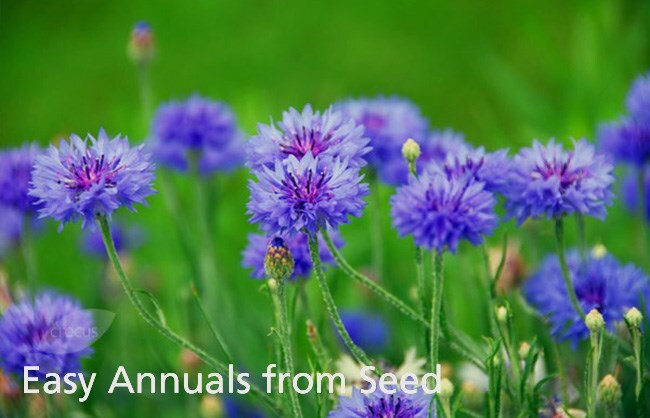| Sow Sweet Peas in Pots Now
There’s still time to sow sweet peas (Lathyrus odoratus) into root trainers or deep pots. This will allow them to develop long roots before being transplanted into enriched soil in March or early April. Fill the pots to within an inch from the top with a good quality compost and spread the seeds out with at least 2cm between each seed. Cover with compost and give the seeds a good watering, using tap water, and place them somewhere cool and mice-free. Cold frames (such as the Large Overlap Cold Frame) are ideal because they provide cool growing conditions, producing sturdier young plants than a greenhouse bench. Pinch out the tips early on, to produce bushier plants, and put your supports in as you transplant outside. Water in dry springs to encourage good growth early on. Don’t worry if you miss the boat with these seeds though as our autumn sown seedlings (which tend to start flowering earlier than spring-sown ones) will get you out of trouble.
 By midsummer you should have a crop of fragrant flowers that can be cut every other day. Pick them in early morning (if you can) and allow them a couple of hours up to their necks in water. This will also allow the pollen beetles to escape. Good, strong Spencer varieties, which are the best for cutting, include the wavy pink ‘Gwendoline’, the deep-blue ‘Oxford Blue’, the pale picotee-edged ‘High Scent’, the pale-blue ‘Charlie’s Angel’ and the deep-lavender ‘Leamington’. The rose-pink ‘Mrs Benard Jones’ is another fabulous addition, made more special by the fact that as a young cadet nurse I was given a bunch of mixed sweet peas by the very man himself, when Bernard Jones was our pharmacist in Leamington in Warwickshire. By midsummer you should have a crop of fragrant flowers that can be cut every other day. Pick them in early morning (if you can) and allow them a couple of hours up to their necks in water. This will also allow the pollen beetles to escape. Good, strong Spencer varieties, which are the best for cutting, include the wavy pink ‘Gwendoline’, the deep-blue ‘Oxford Blue’, the pale picotee-edged ‘High Scent’, the pale-blue ‘Charlie’s Angel’ and the deep-lavender ‘Leamington’. The rose-pink ‘Mrs Benard Jones’ is another fabulous addition, made more special by the fact that as a young cadet nurse I was given a bunch of mixed sweet peas by the very man himself, when Bernard Jones was our pharmacist in Leamington in Warwickshire.
Tough Hardy Annuals
Hardy annuals are not affected by the frost and can and do survive over winter. To generalise they set copious amounts of seed and almost all self-seed when left to their own devices. As a result seedlings often pop up in autumn and they will overwinter unless the weather is extremely harsh. Hardy annuals tend to peak in midsummer, but can be kept going by regular deadheading up until late-August. Then it’s best to leave the plants to produce seeds, which can be collected and kept as long as the heads are harvested in dry weather.
Many hardy annuals are best sprinkled directly into well-prepared soil, as they develop tap roots early on. After sowing they will need covering up with sticks or wire to prevent cat activity. However the soil must be warm before you sow and, for best results, it’s better to wait until early May before doing your sprinkling. Sow too early and germination will be poor. This is very true for the green Bells of Ireland (Moluccella laevis) which is a Turkish native partial to warm sites. This must be sprinkled: it resents disturbance and cannot be pricked out.
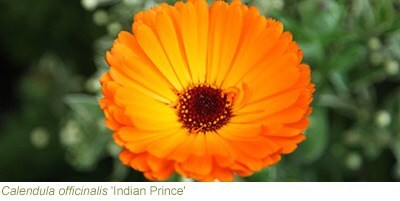
Good ‘sprinklers’ include the orange daisy pot marigold (Calendula officinalis) and there’s a fine orange form called ‘Indian Prince’ which has a mahogany eye that picks up duskier colours. Calendulas have edible petals and these can add extra sparkle to salads, or you can add them to cakes. Their orange flowers also attract helpful hoverflies and these pollinators lay their eggs, singly, close to colonies of aphids. These look like tiny ivory rugby balls. Once the eggs hatch the insectivorous larvae devour lots of garden pests, so orange hoverfly magnets are an excellent addition to the vegetable patch. The large crescent-shaped seeds of pot marigolds are easy to collect, but it’s best to deadhead early on to keep the supply of flowers coming. Add some fiddleneck (Phacelia tanacetifolia) to your ‘sprinkle’ mixture, a lavender-blue bee pleaser, plus some blue borage as a contrast. Phacelia is alive with bees in the evening and it can be dug in as a green manure.
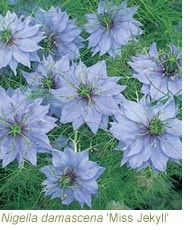 Nigella damascena, more commonly known as Love-in-a-mist, has feathery foliage which is very delicate and wispy - just like moorland mist. The fleeting flowers come in many shades of blue and white including the sky-blue ‘Miss Jekyll’, the white ‘Albion Green Pod’ and the blue and white ‘Delft Blue’. Seed heads follow and are every bit as attractive as the flowers, so deadheading is not advisable. The plump green pods, crowned with seven upright green ‘tendrils’, sometimes have attractive maroon shading. They make a classic dried flower and each cavity is stuffed with plenty of black seeds that ensure next year’s supply. Nigella damascena, more commonly known as Love-in-a-mist, has feathery foliage which is very delicate and wispy - just like moorland mist. The fleeting flowers come in many shades of blue and white including the sky-blue ‘Miss Jekyll’, the white ‘Albion Green Pod’ and the blue and white ‘Delft Blue’. Seed heads follow and are every bit as attractive as the flowers, so deadheading is not advisable. The plump green pods, crowned with seven upright green ‘tendrils’, sometimes have attractive maroon shading. They make a classic dried flower and each cavity is stuffed with plenty of black seeds that ensure next year’s supply.
Poppies are also best sprinkled and, although their flowers are ephemeral, they provide a delicate tissue-paper presence in the summer garden. The flowers are rarely without a hoverfly because poppies produce copious amounts of pollen, but no nectar. Pollen is an essential protein needed for breeding. The seed heads are attractive too, green pepperpots studded in black, but some taller poppies (such as Papaver somniferum) produce vast numbers of seeds. 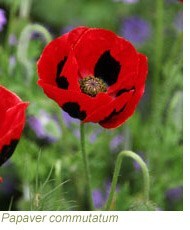 Most seed heads should be removed before they discharge their load. More diminutive poppies need to have their seedpods left alone however and some should be collected and stored and some left to self-seed. The best plants come from autumn-germinating seedlings. The red and black ladybird poppy (P. commutatum) and the divine 'Fairy Wings', a selected form of our own field poppy, are both excellent. When sowing poppy seeds, lie them on the top of the soil surface because light induces germination. Most seed heads should be removed before they discharge their load. More diminutive poppies need to have their seedpods left alone however and some should be collected and stored and some left to self-seed. The best plants come from autumn-germinating seedlings. The red and black ladybird poppy (P. commutatum) and the divine 'Fairy Wings', a selected form of our own field poppy, are both excellent. When sowing poppy seeds, lie them on the top of the soil surface because light induces germination.
Hardy Annuals Better Sown in Trays

Some hardy annuals are best sown in trays in early March, preferably in an unheated greenhouse, and then pricked out into three-inch pots ready for planting out in May or early June. Blue cornflowers make large plants treated in this way and, if deadheaded, this annual can flower over many months. The deep-blue flowers of cornflowers (Centaurea cyanus) cut well and mix with summer-flowering pastels such as phloxes, paler floribunda roses and peonies. The cobalt-blue flowers also set off orange flowers. Darker black-purple forms of cornflower need careful placing however: like many sombre flowers they can merge into the background and disappear from view.
 Annual scabious are also highly successful if pricked out and pot-grown and they flower until late into the year if deadheaded. ‘Black Knight’, although sultry in tone, is saved from being drab by white anthers covering the pincushion. Scabious cut very well and this dark form would be perfect with white umbellifers whether it be the floppier white Ammi majus, or the more-erect August-flowering Ammi visnaga. Or you might use the white snapdragon Antirrhinum majus 'Admiral White’ instead. Other good scabious include the redder ‘Fire King’ and a new lemon-yellow to apricot form of Scabiosa atropurpurea called 'Fata Morgana’. This is far shorter than most and full of cuttable flowers. Annual scabious are also highly successful if pricked out and pot-grown and they flower until late into the year if deadheaded. ‘Black Knight’, although sultry in tone, is saved from being drab by white anthers covering the pincushion. Scabious cut very well and this dark form would be perfect with white umbellifers whether it be the floppier white Ammi majus, or the more-erect August-flowering Ammi visnaga. Or you might use the white snapdragon Antirrhinum majus 'Admiral White’ instead. Other good scabious include the redder ‘Fire King’ and a new lemon-yellow to apricot form of Scabiosa atropurpurea called 'Fata Morgana’. This is far shorter than most and full of cuttable flowers.
Half Hardy Annuals
Half hardy annuals will not survive a winter and they need warmer temperatures to germinate so are best sown in trays once Spring proper arrives. They are often indigenous to the Southern hemisphere and have a tendency to flower better in the second half of summer - once the days begin to get shorter. They can go on until late Autumn and are best sown in trays and then pricked out into individual pots. Plant them outside in early June, to avoid cold shocks, frost and the slugs. They will begin to flower by July and then just carry on.
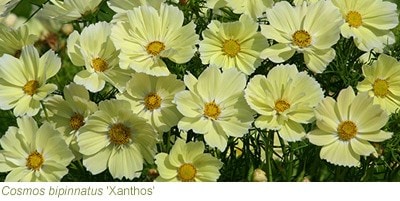
One of the easiest is cosmos, and much plant breeding has produced many new and award-wining forms. These include the lemon-yellow ‘Xanthos’, literally Greek for yellow. It’s won a Fleuroselect Gold medal for 2016 after being trialled extensively across Europe and it’s only short, so it’s more front of border than most - or perfect for a container.
 Most cosmos come in pinks and whites though and some can be tall and imposing such as ‘Sensation Picotee’, a single white with variable dark-pink edging. If you want an easier option, ‘Razzmatazz' has fuller flowers in various shades of pink, white and violet, some with picotee edges. It’s shorter, (up to 90cm) and this is available as ready grown plugs dispatched in March. Most cosmos come in pinks and whites though and some can be tall and imposing such as ‘Sensation Picotee’, a single white with variable dark-pink edging. If you want an easier option, ‘Razzmatazz' has fuller flowers in various shades of pink, white and violet, some with picotee edges. It’s shorter, (up to 90cm) and this is available as ready grown plugs dispatched in March.
Cosmos do well in most gardens, but Zinnia, Nicotiana and Cleome need warmth to thrive so, with our variable British summers, they are always a gamble - although one worth taking. Nicotianas have the added attraction of evening scent, designed to attract moths to their pallid flowers. The most stately, Nicotiana sylvestris, needs space to display its white candelabra of long-tubed flowers. Easier are the shorter forms such as N.‘Lime Green’, which is also a wonderful foil for darker dahlias such as ‘Karma Choc’.

Sowing seeds should be fun and there are two seeds, large and easy to handle, that children love to sow - the Nasturtium and the sunflower. Nasturtium (Tropaeolum majus) can either be sown in pots or sown straight into the ground with one proviso. Any sowing must be after the fear of frosts has passed, so early June is soon enough, because nasturtiums are blackened by the slightest frost. The trailing ‘Alaska’ will give you speckled white foliage, a cascading habit and a sunshine mixture of colourful, edible flowers. ‘Black Velvet’, a compact green-leaved form with sombre-red flowers, is another option. These lovers of poor soil will flower over many months and the large caper-like seeds will self sow, or you can collect them.
 Nasturtiums mix well with another half hardy annual, the French marigold. The red and yellow single ‘Dainty Marietta’ or the fuller-flowered mahogany-red ‘Red Safari’ have a middle that will sustain pollinators which makes them useful close to vegetables. They are also good decoy plants because their aromatic foliage attracts slugs, so it’s possible to collect them up at dusk and this protects slug-sensitive crops such as runner beans. The nasturtium is another decoy, but for cabbage white butterflies, who will often attack this before descending on your edible brassicas. Both provide a blast of sunny colour on border edges. Nasturtiums mix well with another half hardy annual, the French marigold. The red and yellow single ‘Dainty Marietta’ or the fuller-flowered mahogany-red ‘Red Safari’ have a middle that will sustain pollinators which makes them useful close to vegetables. They are also good decoy plants because their aromatic foliage attracts slugs, so it’s possible to collect them up at dusk and this protects slug-sensitive crops such as runner beans. The nasturtium is another decoy, but for cabbage white butterflies, who will often attack this before descending on your edible brassicas. Both provide a blast of sunny colour on border edges.
Sowing annual seeds is a rewarding experience for you and your pollinators, so get busy. |
Things to do
 |
Weed!
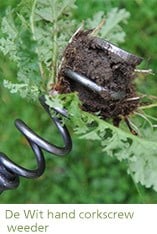
With a mild winter across much of the country, the weeds have hardly missed a beat. Catch up now before they gallop away, removing any rosette formers such as dandelions.
|
 |
Order Dahlia Tubers
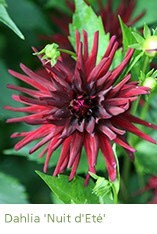
Order your dahlia tubers now and keep them somewhere cool and frost-free. Start them into life in mid-March by planting them in pots of compost. Water sparingly at first and plant out after the last frost.
|
 |
Soft Fruit Feeding and Tidying

Cut back autumn-flowering raspberries and feed with a slow release fertiliser such as Vitax Q4. Tidy the strawberry bed and feed - also with Vitax Q4.
|
 |
Buy Seed Potatoes and Onion and Shallot Sets
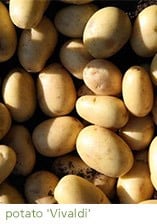
If the potato variety is an Early or Second Early, place the tubers in egg boxes or egg trays, somewhere cool and light, and allow the tubers to chit. Plant from mid-April onwards. ‘Charlotte’ and ‘Vivaldi’ are both excellent.
|
 |
Tidy Greenhouses and Sheds
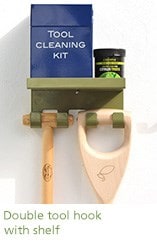
Wash the glass, if you have a greenhouse, to get rid of Winter algae. Tackle the shed too, because once this month’s gone it will be all go. Clean seed trays and pots, discarding any broken ones, and check you have pens, labels and compost.
|
|
|
Essential Kit for February

Windowsill unheated propagator
£3.99
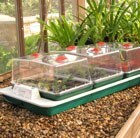
Big 3 electric propagator
£79.99
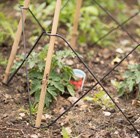
Bamboo obelisk anchoring system
from £9.99
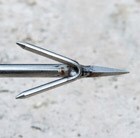
Sneeboer hand wrotter
£29.99
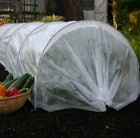
Giant easy fleece tunnel
£24.99
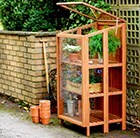
3 Tier eucalyptus growhouse
£399.99 £369.99
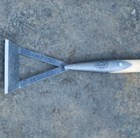
De Wit dutch hoe
£29.99 £22.99
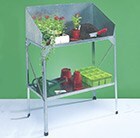
Potting bench galvanised
£44.99
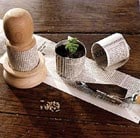
Paper potter
£12.99
|
|



